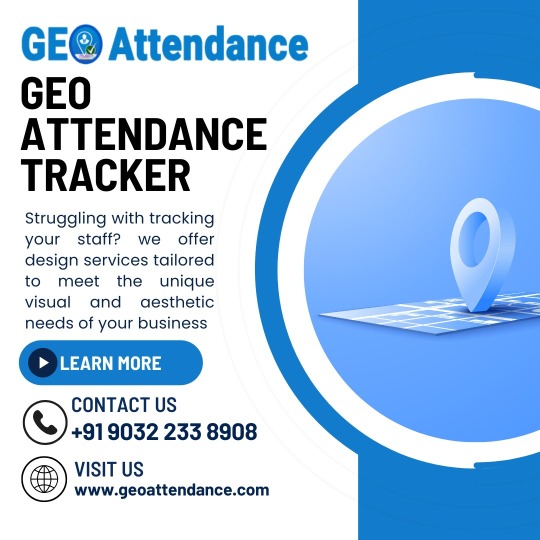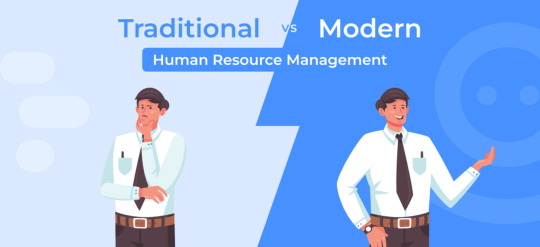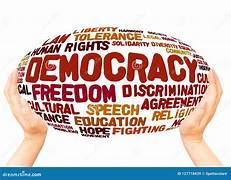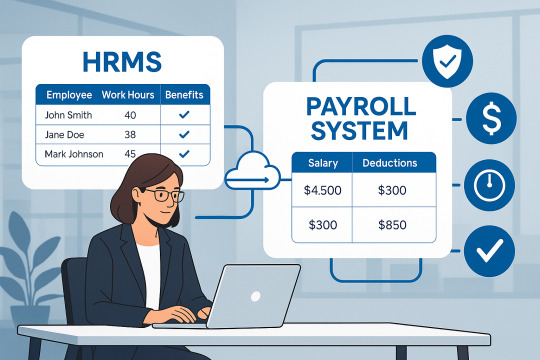#HRMS system benefits
Explore tagged Tumblr posts
Text
HRMS System: 7 Powerful Ways It Can Transform Your Business Operations

In today's fast-paced business environment, efficiency and productivity are paramount. One way businesses are achieving these goals is by leveraging Human Resource Management Systems (HRMS). These systems have evolved from simple employee databases to comprehensive tools that can revolutionize how businesses operate. In this blog, we'll explore seven ways an HRMS system can transform your business operations.
1. Streamlined Recruitment Process
Recruiting top talent is a critical function of any HR department. An HRMS system can significantly streamline the recruitment process by automating many of the tasks involved. From posting job ads to tracking applications and scheduling interviews, an HRMS can handle it all.
Automation of Administrative Tasks
HRMS systems can automate repetitive administrative tasks, freeing up HR professionals to focus on more strategic activities. For example, an HRMS can automatically screen resumes based on predefined criteria, schedule interviews, and send out automated emails to candidates.
Enhanced Candidate Experience
A streamlined recruitment process not only benefits HR but also improves the candidate experience. An HRMS system provides a seamless application process, timely communication, and easy access to information, enhancing the overall candidate experience.
Data-Driven Decision Making
HRMS systems provide detailed analytics and reporting capabilities that can help HR professionals make data-driven decisions. For example, an HRMS can track the source of the most successful hires, helping HR to focus their recruitment efforts on the most effective channels.
2. Improved Employee Onboarding
Employee onboarding is a crucial step in the employee lifecycle. A well-structured onboarding process can lead to higher employee satisfaction and retention rates. An HRMS system can revolutionize the onboarding process by automating and streamlining it.
Personalized Onboarding Plans
An HRMS system can create personalized onboarding plans for new hires, ensuring that they receive the training and resources they need to succeed in their roles. This can include automated workflows, task lists, and access to relevant documents and training materials.
Seamless Integration
An HRMS system can integrate with other systems used by the company, such as payroll and benefits administration, ensuring that new hires are set up in all necessary systems from day one. This reduces the administrative burden on HR and ensures a smooth onboarding process.
Ongoing Support
An HRMS system can provide ongoing support to new hires through self-service portals and access to training materials. This helps new employees quickly get up to speed and feel supported as they transition into their new roles.
3. Enhanced Employee Engagement
Employee engagement is a key driver of productivity and retention. An HRMS system can help improve employee engagement in several ways.
Performance Management
An HRMS system can provide tools for continuous performance management, including goal setting, performance reviews, and feedback. This helps employees stay aligned with company objectives and receive regular feedback on their performance.
Employee Recognition
An HRMS system can include employee recognition programs, allowing employees to recognize and reward their peers for their contributions. This can boost morale and create a positive work environment.
Employee Surveys
An HRMS system can facilitate regular employee surveys to gather feedback on various aspects of the workplace. This feedback can be used to identify areas for improvement and take action to address employee concerns.
4. Efficient Payroll and Benefits Administration
Payroll and benefits administration can be time-consuming and complex. An HRMS system can streamline these processes and ensure accuracy and compliance.
Automated Payroll Processing
An HRMS system can automate payroll processing, ensuring that employees are paid accurately and on time. This includes calculating wages, taxes, and deductions, and generating pay stubs.
Benefits Administration
An HRMS system can simplify benefits administration by providing a self-service portal where employees can enroll in and manage their benefits. This reduces the administrative burden on HR and ensures that employees have easy access to their benefits information.
Compliance
An HRMS system can help ensure compliance with various labor laws and regulations by automating compliance-related tasks and providing regular updates on changes in legislation. This reduces the risk of non-compliance and associated penalties.
5. Data Management and Analytics
Data is a valuable asset for any business. An HRMS system can help manage and analyze HR data to provide valuable insights.
Centralized Data Management
An HRMS system provides a centralized repository for all HR data, making it easy to access and manage. This includes employee records, payroll information, benefits data, and more.
Advanced Analytics
An HRMS system can provide advanced analytics capabilities, allowing HR professionals to analyze data and identify trends. For example, an HRMS can track employee turnover rates, identify the causes of turnover, and develop strategies to improve retention.
Data Security
An HRMS system ensures the security and confidentiality of HR data by implementing robust security measures. This includes data encryption, access controls, and regular security audits.
6. Regulatory Compliance
Compliance with labor laws and regulations is a critical aspect of HR management. An HRMS system can help ensure compliance and reduce the risk of non-compliance.
Automated Compliance Reporting
An HRMS system can automate compliance reporting, ensuring that all necessary reports are generated accurately and on time. This includes reports related to payroll, benefits, and employee records.
Regular Updates
An HRMS system provides regular updates on changes in labor laws and regulations, ensuring that HR professionals are always informed about the latest requirements. This helps to ensure that the company remains compliant with all relevant laws and regulations.
Audit Trails
An HRMS system provides audit trails for all HR activities, making it easy to track and verify compliance-related tasks. This can be especially useful during audits or investigations.
7. Scalability and Flexibility
As businesses grow and evolve, their HR needs change. An HRMS system can provide the scalability and flexibility needed to support this growth.
Scalable Solutions
An HRMS system can scale to accommodate the growing needs of a business. This includes adding new users, expanding functionality, and integrating with other systems.
Customizable Workflows
An HRMS system can provide customizable workflows to meet the unique needs of the business. This includes creating custom workflows for recruitment, onboarding, performance management, and more.
Adaptability
An HRMS system can adapt to changes in the business environment, such as changes in labor laws or shifts in business strategy. This ensures that the HRMS system remains relevant and effective over time.
Conclusion
Implementing an HRMS system can revolutionize your business operations by streamlining processes, improving efficiency, and providing valuable insights. From recruitment and onboarding to payroll and compliance, an HRMS system can transform how your business manages its human resources. By leveraging the power of an HRMS system, businesses can create a more productive, engaged, and compliant workforce, driving long-term success.
3 notes
·
View notes
Text

GeoAttendance offers cutting-edge attendance tracking and workforce management solutions using GPS technology. Streamline employee time tracking, monitor remote teams, and improve productivity with our user-friendly mobile app and software. Discover seamless solutions for businesses of all sizes.
#StreamlineFM#FacilitiesManagement#FMTech#PropTech#BuildingMaintenance#SmartBuildings#WorkplaceSolutions#Efficiency#Productivity#Innovation#GeoAttendance#HRManagement#AttendanceTracking#EmployeeEngagement#WorkforceManagement#HRTech#EmployeeProductivity#hrm software#hrms payroll software#hrms solutions#hrms systems#hrms benefits#businessefficiency#business#employee management software
0 notes
Text
HRMS vs. Traditional HR Systems: Which is Better?
The human resources (HR) function is vital to any organization, as it manages everything from hiring and onboarding to payroll, compliance, and employee engagement. For many years, traditional HR systems have handled these tasks through manual processes and basic software. However, with advancements in technology, Human Resource Management Systems (HRMS) have emerged, offering automation, analytics, and streamlined workflows. So, which system is better for today’s HR needs? In this blog, we’ll compare HRMS and traditional HR systems to help you decide which is the best fit for your organization.
1. Automation and Efficiency
Traditional HR systems typically involve manual processes like filing documents, tracking employee attendance through spreadsheets, and performing payroll calculations by hand. While functional, these systems are prone to human error, inefficiencies, and time-consuming tasks.
On the other hand, HRMS automates key HR functions, from attendance tracking and payroll processing to performance reviews and leave management. Automation reduces the chances of errors, saves time, and allows HR professionals to focus on strategic initiatives rather than routine administrative work.
Winner: HRMS for its efficiency and automation capabilities.
2. Data Management and Accessibility
Traditional HR systems often rely on paper-based records or simple software for data management, which can lead to misplacement, duplication, or outdated information. Accessing this data across different departments can also be cumbersome, requiring time-consuming retrieval methods.
With an HRMS, all employee data is stored in a centralized, digital system. This allows for quick access, real-time updates, and seamless sharing of information across departments. HRMS platforms also often come with cloud-based storage, which means employees and managers can access critical data from anywhere, promoting flexibility and remote work.
Winner: HRMS for centralized data storage and easy access.
3. Compliance and Reporting
Maintaining compliance with labor laws, tax regulations, and company policies is a significant challenge for HR departments using traditional systems. Manual tracking of changes in laws and regulations increases the risk of non-compliance, which could lead to legal penalties.
An HRMS simplifies compliance by automating updates and notifications regarding changes in labor laws and tax codes. It generates real-time reports that ensure your organization is staying compliant. Moreover, HRMS allows for custom reporting, making it easier to track key metrics like employee turnover, attendance, and payroll.
Winner: HRMS for automated compliance tracking and robust reporting features.
4. Employee Self-Service
In traditional HR systems, employees often have to reach out to the HR department to check their leave balance, request time off, or update their personal information. This creates bottlenecks and adds to HR's workload.
With an HRMS, employee self-service portals empower employees to handle many of their own HR tasks, such as applying for leaves, downloading payslips, and updating personal details. This improves the employee experience and reduces the burden on the HR team.
Winner: HRMS for its employee self-service capabilities.
5. Scalability
Traditional HR systems can become unwieldy as an organization grows. Manually managing more employees, payroll data, and compliance issues becomes increasingly difficult, leading to inefficiencies and mistakes.
An HRMS is designed to scale with your business. Whether you're a small startup or a large corporation, an HRMS can easily handle growth by automating tasks and integrating new features as your business expands.
Winner: HRMS for its scalability and adaptability.
6. Cost Considerations
Traditional HR systems often appear cheaper upfront because they may not require sophisticated software or automation tools. However, the hidden costs of inefficiency, manual labor, errors, and compliance risks can quickly add up.
While HRMS platforms typically have higher upfront costs, the long-term savings from automation, reduced errors, better compliance, and improved productivity often justify the investment. Many HRMS providers also offer subscription-based models that allow businesses to spread costs over time.
Winner: HRMS for long-term cost savings and value.
7. Customization and Flexibility
Traditional HR systems often come with limited customization options, relying on a one-size-fits-all approach. As a result, they may not cater to the specific needs of your organization.
HRMS platforms are highly customizable, allowing businesses to tailor the system to their unique requirements. You can choose the features you need, such as recruitment modules, performance tracking, or employee engagement tools, and scale up as your business evolves.
Winner: HRMS for flexibility and customization options.
Conclusion: Which Is Better?
While traditional HR systems have served businesses for years, they are quickly becoming outdated in today’s fast-paced, technology-driven work environment. HRMS platforms provide automation, scalability, and advanced reporting features that traditional systems cannot match. From saving time to reducing errors and improving compliance, the benefits of an HRMS far outweigh those of traditional HR processes.
For businesses looking to streamline their HR functions, improve efficiency, and gain a competitive edge, investing in an HRMS is a clear winner.
Visit Here: https://ahalts.com/products/hr-management

#HRMS vs traditional HR systems#Benefits of HRMS over traditional HR#HRMS vs manual HR systems#Traditional HR system limitations#HRMS vs legacy HR software
0 notes
Text
Transforming Workforce Excellence: The Role of HR Performance Management Systems
In the dynamic landscape of modern workplaces, the strategic management of human resources has become pivotal for organizational success. One of the cornerstones of this strategy is the implementation of robust HR Performance Management Systems. These systems go beyond traditional performance reviews, offering a comprehensive approach to optimizing employee performance, fostering professional growth, and aligning individual goals with organizational objectives.
Understanding HR Performance Management Systems
An HR Performance Management System is a set of integrated processes and tools designed to streamline the management of employee performance, development, and overall productivity within an organization. Unlike the traditional annual performance review model, modern systems emphasize continuous feedback, goal alignment, and data-driven decision-making.
Key Components of HR Performance Management Systems
Goal Setting and Alignment:
HR performance management systems facilitate the setting of SMART (Specific, Measurable, Achievable, Relevant, Time-Bound) goals for employees. These goals are aligned with the broader organizational objectives, ensuring that every individual's efforts contribute to the overall success of the company.
Continuous Feedback Mechanisms:
Emphasizing ongoing feedback, these systems enable regular communication between managers and employees. This approach fosters a culture of continuous improvement, allowing for real-time adjustments, acknowledgement of achievements, and addressing performance issues promptly.
Employee Development Planning:
HR performance management systems go beyond evaluation to focus on employee development. They provide a platform for creating personalized development plans, identifying skill gaps, and offering opportunities for training and growth.
360-Degree Feedback:
Modern systems often incorporate 360-degree feedback, gathering insights from peers, subordinates, and managers. This holistic feedback approach provides a well-rounded view of an employee's performance, encouraging a more comprehensive understanding of strengths and areas for improvement.
Data Analytics and Reporting:
Leveraging data analytics, HR performance management systems offer valuable insights into performance trends, skill gaps, and the impact of development initiatives. Data-driven reporting supports informed decision-making and strategic workforce planning.
Recognition and Rewards:
Recognition is a crucial aspect of employee motivation. HR performance management systems include mechanisms for acknowledging and rewarding high performers. This recognition can take various forms, including monetary rewards, promotions, or public acknowledgment of achievements.
Integration with Learning and Development Initiatives:
These systems are often integrated with learning and development platforms. This integration allows employees to seamlessly access training materials, courses, and resources that align with their development goals identified through the performance management process.
Benefits of HR Performance Management Systems
Enhanced Employee Engagement:
By providing a continuous feedback loop and involving employees in goal-setting and development planning, HR performance management systems contribute to increased engagement. Engaged employees are more likely to be motivated and committed to organizational goals.
Improved Productivity and Performance:
Goal alignment, regular feedback, and development opportunities lead to improved employee performance and increased productivity. When employees understand their role in achieving organizational objectives, they are more likely to strive for excellence in their work.
Talent Retention and Recruitment:
Recognizing and rewarding high performers enhances talent retention. A positive performance management experience becomes a powerful tool for attracting top talent, as prospective employees seek organizations that invest in their professional growth and well-being.
Strategic Decision-Making:
The data generated by HR performance management systems provides valuable insights for strategic decision-making. HR leaders can identify trends, assess skill gaps, and make informed decisions about workforce planning and development initiatives.
Cultural Reinforcement:
These systems play a crucial role in reinforcing organizational culture. By aligning performance expectations with cultural values, organizations can create a workplace where employees embody the desired behaviors and attitudes.
Adaptability to Change:
HR performance management systems support adaptability by identifying skill sets needed for evolving roles. This adaptability ensures that employees are equipped with the skills required to navigate changes in the business environment.
Fair and Transparent Evaluation:
Modern systems promote fairness and transparency in performance evaluations. Clear criteria, consistent application, and the use of data-driven metrics reduce the likelihood of bias and subjective judgments.
Challenges and Considerations
While HR performance management systems offer numerous benefits, their successful implementation requires careful consideration of potential challenges. Some common challenges include:
Resistance to Change:
Employees and managers may resist the shift from traditional performance reviews to a more continuous and feedback-oriented approach. Effective communication and change management strategies are essential to address resistance.
Technology Integration Issues:
Integrating the system with existing HR technology infrastructure can pose challenges. Ensuring seamless integration and providing adequate training for users are critical to overcoming technology-related issues.
Subjectivity in Evaluation:
Despite efforts to make evaluations objective, there is still a risk of subjectivity. Training managers on fair and unbiased assessment practices can help mitigate this challenge.
Balancing Quantitative and Qualitative Metrics:
Striking the right balance between quantitative and qualitative metrics is crucial. Overemphasis on one at the expense of the other may lead to an incomplete view of employee performance.
Conclusion
In the ever-evolving landscape of human resource management, HR performance management systems have emerged as indispensable tools for fostering employee excellence, aligning organizational goals, and driving strategic decision-making. By embracing these systems, organizations can create a culture of continuous improvement, engagement, and innovation, ultimately propelling them toward sustained success in today's competitive business environment.
#HR Performance Management System#Performance Management System#Performance Management System in HRM#Objectives of Performance Management System#Benefits of Performance Management System#Employee Performance Management System
0 notes
Text
Readings in the Philippines History
Caparas, Regina Deyweness
Cardiel, Phoebe Lynn
Hernaez, Jhan Celso
HRM 2B
Part 1
Definition of terms
1. Colonialism
Colonialism is a political and economic system in which a foreign country establishes and maintain control over a country and it often involves political, cultural and exploitation of resources by the colonizing power the Philippines.

11. Imperialism
Imperialism is when a powerful country takes control of a weaker country or territory. Often to exploit its resources, labor or markets. This can be done through military force, economic pressure or cultural influence.

111. Philippines Trade History (Spanish Era)
The Philippines was a major hub for the galleon trade, which connected Asia, The Americans and Europeans. While it was a time of great cultural exchange but also of exportations and inequality, As the spanish colonizers dominated the trade and reaped most of the benefits.

1v. Nationalism
A strong sense of pride, loyalty and devotion to one's country and its people. It emphasizes the importance of national identity and unity. Nationalism emerged in the Philippines as a response to colonialism and foreign domination asserting our country's independence promoting its culture, interest and resist foreign influence.

v.Decolonization
Decolonization is about countries taking back control and becoming truly independent. In the Philippines, Decolonization starts when our fellow countrymen began to break free from being controlled by the Spaniards for a very long time.

v1. Swidden Cultivation
Also known as slash-and-burn agriculture, is a farming practice where forests are cleared by cutting and burning vegetation. This enriches the soil with nutrients for a few years. Farmers then grow crops in the cleared area until soil fertility declines, after which they move to a new site.

v11.Boxer Codex
A 16th-centurymanuscript from the Philippines, featuring illustrations and descriptions of indigenous peoples, cultures, and wildlife. It provides valuable insights into precolonial Philippine society, customs, and attire, serving as a key historical document for understanding the region's early history and cultural diversity.

v111.Pious
Someone who is deeply religious, devoted to their faith, and often demonstrates strong moral principles. Such individuals engage in acts of worship, practice religious rituals, and strive to live according to their beliefs. Piety can manifest through compassion, charity, and a commitment to spiritual values.

1x. Kasamas
Refers to companions, partners, or friends in Filipino culture. The term embodies camaraderie, loyalty, and shared experiences. It emphasizes the importance of relationships and support among individuals in various contexts, such as family, friendship, or community, highlighting togetherness and mutual assistance in life's journey.

x.Democracy
A system of government where power lies with the people. Citizens have the right to vote and participate in decision-making. It promotes fairness, freedom, and equality. In a democracy, leaders are elected, laws are made transparently, and individual rights are protected, allowing diverse voices to be heard.

2 notes
·
View notes
Text
Discover the magic of transforming your workplace with our latest YouTube content on the successful implementation of Human Resource Management Systems (HRMS)! Whether you're an HR pro or just curious about the benefits of HRMS, our engaging videos break down best practices, real-life success stories, and practical tips to help you unleash the full potential of your HR strategy. Don't miss out—let's revolutionize your HR game together! To listen to the full video click on the link given.
#best hrms software companies in india#podcast#salesforce implementation#hrms payroll software#learning management system in india#employee helpdesk
2 notes
·
View notes
Text
The Role of Innovation in Business Growth with HRMS System

Innovation is a critical driver of business growth, enabling companies to stay competitive, enhance operational efficiency, and meet the evolving needs of their workforce. One area where innovation has had a profound impact is in the implementation of Human Resource Management Systems (HRMS). An HRMS System is a comprehensive suite of software applications designed to manage human resources and related processes throughout the employee lifecycle. This essay explores in detail how innovation through HRMS contributes to business growth, covering aspects such as streamlining HR processes, improving data management and decision-making, enhancing employee experience, facilitating remote work and flexibility, supporting strategic HR initiatives, ensuring compliance and risk management, and providing scalability.
1. Streamlining HR Processes
Automation
One of the most significant innovations brought about by HRMS is the automation of repetitive and time-consuming tasks. Payroll processing, attendance tracking, benefits administration, and other routine activities can be automated, freeing up HR professionals to focus on more strategic tasks. Automation reduces the likelihood of errors, ensures timely and accurate payroll, and improves overall efficiency. For instance, automated time and attendance systems can track employee hours, manage leave requests, and integrate seamlessly with payroll systems, ensuring that employees are paid accurately and on time.
Efficiency
HRMS systems streamline various HR processes, making them more efficient and less prone to errors. Recruitment, onboarding, performance management, and training are all processes that can be optimized through HRMS. For example, automated recruitment tools can handle job postings, resume screening, and interview scheduling, significantly reducing the time and effort required to hire new employees. Onboarding software can provide new hires with all the information they need, track their progress, and ensure a smooth transition into the company. Performance management systems can set goals, track progress, and provide feedback in real-time, fostering continuous improvement and development.
2. Improving Data Management and Decision Making
Centralized Data
An HRMS centralizes all employee data, making it easily accessible and manageable. This centralized data repository improves compliance with legal requirements and company policies by ensuring that all necessary information is stored securely and can be retrieved when needed. For instance, maintaining accurate records of employee qualifications, certifications, and training can help ensure compliance with industry regulations and standards.
Analytics
Advanced HRMS systems offer powerful analytics and reporting tools that help in tracking key HR metrics, identifying trends, and making data-driven decisions. By analyzing data on employee performance, engagement, turnover, and other metrics, HR managers can gain valuable insights into workforce dynamics and identify areas for improvement. For example, analytics can reveal patterns in employee turnover, helping HR identify the root causes and develop strategies to improve retention. Predictive analytics can forecast future HR needs, enabling proactive workforce planning and resource allocation.
3. Enhancing Employee Experience
Self-Service Portals
HRMS often includes self-service portals where employees can manage their own information, request time off, and access company resources. This improves the employee experience by providing more control and transparency. Employees can update their personal information, view their pay stubs, and access benefits information without having to go through HR. This not only empowers employees but also reduces the administrative burden on HR staff.
Career Development
Tools for performance management, training, and development planning help employees grow within the company, which can increase job satisfaction and reduce turnover. Performance management systems provide regular feedback and support continuous development, while learning management systems offer access to training and development resources. Career development plans can help employees set goals, identify career paths, and acquire the skills needed for advancement. By investing in employee development, companies can foster a culture of continuous learning and growth, leading to higher employee engagement and retention.
4. Facilitating Remote Work and Flexibility
Cloud-Based Solutions
The rise of remote work has highlighted the importance of cloud-based HRMS solutions. Cloud-based HRMS systems enable remote access to HR functions, ensuring that employees and HR teams can perform their tasks from anywhere. This flexibility is essential in today's work environment, where employees expect the ability to work remotely and access information on-demand. Cloud-based solutions also offer scalability, allowing businesses to expand their HR capabilities as they grow.
Communication Tools
Integration with communication platforms can improve collaboration and communication among remote teams. HRMS systems can integrate with tools like Slack, Microsoft Teams, and Zoom, facilitating real-time communication and collaboration. This integration ensures that remote employees stay connected, engaged, and informed. Additionally, HRMS can support virtual onboarding and training, ensuring that remote employees receive the same level of support and development as their in-office counterparts.
5. Supporting Strategic HR Initiatives
Talent Management
Advanced HRMS features for talent acquisition, development, and retention help companies build a strong workforce that aligns with business goals. Talent management modules can streamline the recruitment process, making it easier to attract, assess, and hire top talent. Once employees are on board, HRMS can support their development through performance management, training, and career planning. By aligning talent management with business objectives, companies can ensure that they have the right people in the right roles, driving business growth.
Succession Planning
Identifying and developing future leaders within the company is easier with the help of comprehensive data and analytics provided by HRMS. Succession planning tools can identify high-potential employees, assess their readiness for leadership roles, and create development plans to prepare them for future responsibilities. By proactively managing succession planning, companies can ensure a smooth transition of leadership and maintain business continuity.
6. Compliance and Risk Management
Regulatory Compliance
An HRMS can help ensure compliance with labor laws and regulations by keeping accurate records and providing timely updates on legal changes. HRMS systems can track employee qualifications, certifications, and training, ensuring compliance with industry standards and regulations. Additionally, automated compliance checks can identify potential issues before they become problems, reducing the risk of fines and penalties.
Risk Mitigation
By maintaining detailed and accurate records, an HRMS can reduce the risk of errors and legal issues related to HR processes. For example, accurate time and attendance records can prevent disputes over working hours and overtime pay. Employee records can also provide documentation in the event of legal disputes, protecting the company from potential liability.
7. Scalability
Growth Support
As a company grows, an HRMS can scale to handle increased HR demands, whether that involves managing a larger workforce or expanding into new regions. HRMS systems can support multiple locations, currencies, and languages, making it easier for companies to manage a global workforce. Additionally, scalable HRMS solutions can handle increased data volume and complexity, ensuring that HR processes remain efficient and effective as the company grows.
Customizable Solutions
Many HRMS systems offer customizable modules that can be tailored to meet the specific needs of a growing business. Customizable solutions allow companies to add or modify features as their needs evolve, ensuring that the HRMS continues to support business growth. For example, a company might start with basic payroll and attendance modules and later add advanced talent management and analytics features as their HR needs become more complex.
Conclusion
Innovation in HR through the adoption of an HRMS can significantly drive business growth by enhancing efficiency, improving decision-making, and creating a better employee experience. By automating routine tasks, streamlining processes, and providing powerful analytics, HRMS systems enable HR teams to focus on strategic initiatives that drive business success. Additionally, HRMS solutions enhance employee experience by providing self-service options, supporting career development, and facilitating remote work. They also ensure compliance with legal requirements, mitigate risks, and provide scalability to support business growth. As businesses continue to evolve in a digital landscape, leveraging innovative HR technologies becomes increasingly crucial for maintaining a competitive edge and achieving long-term success.
HRMS systems represent a significant investment in the future of human resources, transforming the way companies manage their workforce and driving business growth through innovation. By embracing the capabilities of HRMS, companies can build a more agile, efficient, and engaged workforce, positioning themselves for success in an ever-changing business environment.
4 notes
·
View notes
Text
Writer Q&A Tag Game!
I got tagged by @touloserlautrec on this one and you can see their answers here.
I'm not sure who hasn't gotten this one yet but I'm no pressure tagging @squarebracket-trick @captain-kraken @vsnotresponding & @tisiphonewolfe (and open tag)
1. What motivates you to write?
The whole absurdly-large scope of Sunset is going on in my head whether I'm writing it or not. You know when you have a song oppressively stuck in your head and the only thing that helps is to listen to the song all the way through? It's like that. If I don't write it out, my brain just churns it over and over on a loop.
2. A line/short snippet of your writing that you are most proud/happy of. If not maybe share a line of someone else's work you love (just please credit them)
Ooo. Hrm. Here's something from Arc 2.
Gerrit's heart sank. The idea that this sort of attack was more than a sporadic phenomenon was a dreadful, heavy thing that he didn't have proper words for. But that was the benefit of telepaths--he didn’t have to. When Gerrit would normally have needed to look away, attempting to grasp his fingers around some sort of words that even remotely fit the gravity of what he was being told, instead he just looked at Penn and felt. Penn held his gaze for a moment and Gerrit felt a gentle nudge of his telepathy. Penn understood. “Go.” Penn clapped him on the back.
3. Which OC makes you smile every time you think/talk about them and what are they like?
It's tough to pick! I'll say Marek just because I enjoy his antics and stalwart refusal to be a "serious corporate adult" while being one of the most competent people in the Corp. (Plus he and Baguette are a package deal.)
5. What part of writing do you think you are the best at? (Yes stroke your own ego it's okay)
I guess I'd have to say planning/mapping the big picture. Sunset covers a lot of threads that all branch out to affect others down the line with cascading consequences. It's all connected somehow and I feel like I do a decent holding it all in my head.
(That and I think I can write some pretty damn funny dialogue to break up the tension of the rest of the story.)
6. What is something in the writeblr community is most enjoyable?
The people! It's so amazing to meet so many supportive writers and get to get excited about everyone's projects. Listening to other rant about their oc babies brings me so much joy.
7. A writing tool/device you use that helps you with writing? (It could be speech to text, a writing program etc)
I've been using StimuWrite 2 which has been a great motivating tool. It's a program helps to keep me focused and I can create a mini fake coffee shop background with it.
8. A piece of worldbuilding that you like in your own story? (It could be the magic system, a particular place in the story, a law etc)
I love our take on telepaths because it's not a matter of just hearing thoughts or seeing them like on a movie screen. It's synesthetic and young telepaths have to learn to translate this internal language.
Each telepath's experience is different. Penn's is heavily smell-based like information he takes into his body from outside. Jake's is more external with sounds and physical sensations pressing themselves onto his skin, wrapping around him. Reeve's is more internal with tastes and colors that flow from the backs of his eyes and down his throat like a liquid--so if his knack gets overwhelming it can make him feel like he's choking or drowning.
I like to think that how telepaths perceive their knack has an influence on them in the same way that what knack someone has will influence who they are. (This also makes conflict between telepaths really interesting to write!)
9. What piece of advice would you say to encourage others to write if they are having a rough patch?
Allow yourself to have fallow times where you aren't writing. That's part of the process. I think the saying is something like anything in nature that is producing endlessly without rest or renewal is dying.
Don't give up on your projects, write that shitty first draft, but don't beat yourself up with guilt when your brain needs a break.
13 notes
·
View notes
Text
ERP Software for the Manufacturing Industry: Streamline, Scale, and Succeed
Introduction: Manufacturing Meets Modern Efficiency
Manufacturing is no longer just about machines and manpower. It’s about precision, speed, and adaptability. As the global market becomes more dynamic, manufacturers are turning to technology to stay ahead. One solution has proven indispensable—ERP (Enterprise Resource Planning) software. It's not just a digital tool; it's the operational heartbeat of modern manufacturing enterprises, large or small.
What Is ERP Software in Manufacturing?
At its core, ERP software is a centralized system that unites all key functions of a manufacturing business—production planning, inventory, procurement, sales, finance, and beyond—into a single, cohesive platform. Instead of juggling multiple software tools or relying on spreadsheets, manufacturers can manage every process from a unified dashboard.
This integration is more than convenience. It’s about real-time control, smarter decisions, and creating a seamless flow of information across departments.
Key Benefits of ERP for Manufacturers
1. End-to-End Visibility ERP gives manufacturers a bird’s-eye view of their operations. From raw material sourcing to finished product delivery, every stage is traceable and transparent. This level of visibility leads to faster response times and fewer costly surprises.
2. Inventory Optimization Say goodbye to overstocking or sudden shortages. ERP systems manage stock levels intelligently, ensuring materials are available when needed without tying up capital in excess inventory.
3. Production Planning and Scheduling With real-time data, manufacturers can schedule jobs efficiently, allocate resources wisely, and reduce bottlenecks on the shop floor. The result? Better productivity and fewer delays.
4. Quality Control and Compliance Maintaining consistent product quality is non-negotiable. ERP software helps track quality checks, monitor deviations, and ensure regulatory compliance with ease.
5. Cost Efficiency ERP pinpoints inefficiencies and eliminates redundant processes. Over time, this translates into reduced operational costs and improved profit margins.
Must-Have Features in Manufacturing ERP Software
When selecting an ERP system for manufacturing, look for features designed to meet industry-specific needs:
Bill of Materials (BOM) Management Accurately define product structures and dependencies to streamline assembly processes.
Production Routing and Work Orders Map out manufacturing workflows, assign tasks, and track execution in real time.
Material Requirements Planning (MRP) Forecast demand and plan procurement to ensure uninterrupted production.
Shop Floor Control Monitor live data from the production line to manage labor, machines, and output efficiently.
Supply Chain Integration Coordinate with vendors, suppliers, and logistics to ensure smooth inbound and outbound operations.
Real-Time Reporting & Analytics Gain insights into performance metrics, cost analysis, and delivery timelines—all in a few clicks.
Challenges ERP Solves in Manufacturing
The manufacturing world isn’t without its hurdles. Fluctuating demand, resource shortages, delayed shipments, and quality issues can disrupt the entire chain. ERP systems tackle these head-on by:
Minimizing downtime through predictive maintenance scheduling.
Reducing human error with automation.
Accelerating decision-making through real-time dashboards.
Facilitating agile responses to market shifts.
By eliminating silos and enabling seamless communication, ERP helps manufacturers operate with confidence—even during turbulent times.
How ERP Supports Growth and Scalability
As businesses expand, so do their complexities. ERP software ensures scalability by offering modular functionality. Start with core modules like inventory and finance, and add more—like CRM or HRM—as needs evolve.
Whether opening a new facility, launching a new product line, or entering international markets, ERP acts as a reliable backbone that adapts and grows with the business.
Cloud vs. On-Premise ERP: What’s Best for Manufacturers?
Today’s ERP solutions come in two main flavors:
Cloud-Based ERP: Hosted on remote servers, offering flexibility, remote access, and reduced IT overhead. Perfect for manufacturers with multiple sites or mobile teams.
On-Premise ERP: Installed locally with higher control and customization. Ideal for large enterprises with strict data security policies.
Each has its merits. The right choice depends on business size, budget, and infrastructure readiness.
Choosing the Right ERP Partner for Manufacturing
Implementing ERP is a strategic move, not just a software installation. Partnering with an experienced ERP provider ensures:
Industry-specific expertise
Seamless customization
Proper staff training
Ongoing support and updates
Look for a partner who understands manufacturing pain points and offers tailored solutions—not one-size-fits-all software.
Conclusion: Manufacturing Smarter with ERP
In today’s high-stakes manufacturing environment, precision and agility are key. ERP software brings structure to complexity, replacing guesswork with insight and manual errors with automation. It’s not just about keeping up—it’s about staying ahead.
From better resource planning to enhanced customer satisfaction, ERP equips manufacturers to thrive in a competitive market. For any manufacturing business ready to modernize and scale, ERP is the cornerstone of sustainable success.
Contact Us – Banibro IT Solutions (Serving India & UK)
Looking to implement ERP in your manufacturing business?
Banibro IT Solutions specializes in providing tailored ERP solutions that empower manufacturers to streamline operations and boost productivity. With proven expertise and presence in both India and the UK, our team is ready to support your digital transformation journey—no matter where you operate.
📍 UK Office Banibro IT Solutions
47 White Lodge Close, Sutton, SM25TQ, UK.
📞 +44 [ 7442005338]
📧 Email: [email protected] Let’s make manufacturing smarter, together. Reach out today for a free ERP consultation.
0 notes
Text

#StreamlineFM#FacilitiesManagement#FMTech#PropTech#BuildingMaintenance#SmartBuildings#WorkplaceSolutions#Efficiency#Productivity#Innovation#hrms payroll software#hrm software#hrms solutions#hrms systems#hrms benefits#business#employee management software
0 notes
Text
From Onboarding to Payroll: How Smart HR Services Keep SMEs Running Smoothly

Running an SME is like juggling flaming torches while riding a unicycle—blindfolded. Every day brings new challenges, and amidst the chaos of sales, operations, and client management, HR and payroll often take a backseat. But let’s be honest—when payroll errors creep in, compliance deadlines are missed, or employee dissatisfaction rises, it’s not just an inconvenience—it’s a business risk.
Many SME owners believe that HR is something they can ‘manage on the side’ until it turns into a full-blown crisis. That’s where HR services for SMEs come into play, offering the much-needed structure, efficiency, and compliance that businesses need to thrive.
Seamless Paperless Onboarding: A Game-Changer for SMEs
Gone are the days of piles of paperwork and endless manual data entry. With HR services for SMEs, onboarding new employees becomes a smooth, digital-first experience.
Onboard Employees Digitally – Say goodbye to printed forms and lengthy processes. Employees can now submit documents, sign agreements, and complete formalities online—saving time and reducing errors.
Quick Formality Completion – Speed up the onboarding process with automated workflows that ensure new hires are ready to work from day one. No more chasing signatures or missing documents!
Maintain Employee History Digitally – Keep all employee records in one secure location. From personal details and job history to appraisals and training records, everything is stored digitally for easy access.
Mobile-Friendly Onboarding – With an android application for employees, new hires can complete onboarding tasks right from their phones—whether they’re at home, in transit, or at the office.
By switching to a paperless onboarding system, SMEs can create a hassle-free, efficient, and eco-friendly hiring experience.
Streamlining Payroll & Compliance Without the Stress
Payroll should be a seamless process, not a recurring monthly panic attack. An efficient payroll system ensures that salaries are processed on time, tax deductions are accurate, and compliance is maintained. HR services for SMEs eliminate the guesswork in payroll management by automating calculations, tax filings, and benefits administration. This allows SME owners to focus on what truly matters—growing their business.
Additionally, SME HR services keep businesses compliant with government regulations, ensuring every contract, policy, and tax submission is in order. No more late-night Google searches on "labour laws every SME should know."
Optimizing HR Operations for Growth
SMEs may not have large HR teams, but that doesn’t mean they should struggle with inefficient processes. SME HRMS software simplifies workforce management by tracking attendance, leave balances, and employee performance in real time.
This means:
No more paperwork mountains – Everything from employee records to appraisals is digitalised. Smooth onboarding – New hires feel welcomed with a structured process, setting them up for success. Clear policies – Employees know exactly what’s expected, reducing misunderstandings.
A well-structured HR system isn’t just about ticking boxes; it fosters transparency, reduces confusion, and builds a workplace culture where employees feel valued and motivated.
Engaged Employees = Stronger Business Performance
Employees don’t just work for a paycheck—they want to feel valued. When HR is chaotic, it affects morale, productivity, and ultimately, business performance.
With SME HR solutions, SMEs can:
Offer timely salary payments & benefits to boost trust and satisfaction.
Set up clear performance metrics for fair appraisals and promotions.
Implement structured training & development plans to nurture future leaders.
The result? A motivated workforce that stays, performs, and helps drive the business forward.
The Smart Way to Manage HR & Payroll
Managing HR and payroll efficiently isn’t about adding more tasks to the SME owner's plate—it’s about removing unnecessary burdens. The right HRMS solution brings automation, compliance, and employee satisfaction together in one seamless system.
Opportune HR empowers SMEs with tailored HR software for SMEs, ensuring effortless payroll processing, legal compliance, and workforce management—all without the administrative headaches. It is built for startups, offering smart automation, seamless payroll, and compliance-ready solutions. Unlike generic software, it adapts to your growing needs, keeping you agile and efficient. Book a demo today!
0 notes
Text
Modernize IT Infrastructure with Wenbear’s Scalable SaaS Models
In today’s digital-first world, agility, scalability, and reliability define the foundation of successful businesses. Traditional IT infrastructure often struggles to keep up with the demands of rapid growth, evolving technology, and remote workforces. This is where Wenbear Technology’s Scalable SaaS (Software as a Service) Models step in — offering a modern, cloud-powered alternative that’s flexible, cost-efficient, and built for innovation.
Why IT Modernization Matters
Many businesses still rely on legacy systems — outdated software, on-premise servers, manual workflows, and patchy integration tools. These systems not only increase operational costs but also limit your ability to scale, collaborate, and innovate.
Modernizing IT infrastructure isn't just about replacing old technology; it's about adopting a mindset of continuous transformation — where scalability, automation, and data-driven decisions become the new normal.
Enter SaaS: The Engine Behind Digital Transformation
SaaS is a cloud-based software delivery model where applications are hosted online and accessed through a web browser. Unlike traditional software that requires installation, licensing, and manual updates, SaaS solutions are subscription-based, scalable, and continuously upgraded.
Key Benefits of SaaS for IT Modernization:
Reduced Capital Expenditure: No need for heavy upfront investments in servers, licenses, or hardware.
Seamless Upgrades: Automatic updates mean your systems are always running the latest version with the best security.
Remote Accessibility: Users can access systems anytime, from anywhere — boosting collaboration and productivity.
Scalability: Instantly scale up or down as per your business needs without IT overhauls.
Faster Deployment: Launch new tools in days, not months.
Wenbear Technology: Pioneering Scalable SaaS Models
At Wenbear Technology, we specialize in delivering customized SaaS platforms that align with your business’s goals and technical needs. Whether you're a startup, SME, or enterprise, our scalable solutions adapt to your growth trajectory — ensuring you never outgrow your systems.
Our SaaS Offerings Include:
HRM, CRM & Project Management Platforms
Cloud-Based POS Systems
AI-Powered Customer Service Tools
Social Media Management Dashboards
Accounting & Payroll Automation Tools
Gym & Fitness Center Software
Inventory & Finance Management Systems
Each of these solutions is modular, customizable, and cloud-native — meaning you can plug in features as your business evolves.
The Wenbear Advantage: Built for Growth
Here’s how our SaaS infrastructure modernizes your operations:
1. Modular Architecture for Tailored Experiences
No two businesses are alike. Wenbear’s SaaS platforms follow a modular architecture, allowing you to choose only the features you need — whether it's analytics, billing, inventory, or team collaboration. This not only saves cost but ensures that your system grows with your organization.
2. Multi-Tenant Cloud Framework
Our solutions are designed for multi-location, multi-departmental businesses. With a centralized control panel, you can manage operations across locations while maintaining local-level access and security.
3. AI & Automation at the Core
We embed AI algorithms and automation workflows to make your systems smarter. From chatbot-assisted support to predictive analytics and workflow automation — Wenbear’s SaaS platforms help reduce human error and speed up decision-making.
4. Seamless Integration Capabilities
Wenbear’s SaaS products can integrate with third-party tools and APIs — including ERPs, payment gateways, marketing tools, and e-commerce platforms — so your tech ecosystem remains connected and efficient.
5. Enterprise-Grade Security
Security is non-negotiable. Our SaaS platforms come with role-based access, encrypted data storage, multi-layer authentication, and daily backups — ensuring your data is always protected.
Case Study: Scaling with Wenbear SaaS
A mid-sized retail chain approached Wenbear for IT modernization. They were using different POS systems across branches, managed payroll manually, and lacked a centralized CRM.
With Wenbear’s Retail SaaS Suite, they achieved:
40% faster inventory updates across branches
60% reduction in payroll processing time
20% increase in customer retention through smart CRM integration
Complete mobile accessibility for remote management
Ideal Industries for Wenbear’s SaaS Solutions
Our scalable SaaS models serve a wide range of sectors, including:
Retail & E-commerce
Healthcare & Wellness
Hospitality & Travel
Education & EdTech
Real Estate & Construction
Finance & Accounting
Marketing Agencies
Human Resource Consultancies
How to Get Started with Wenbear SaaS
We follow a simple 4-step approach to modernizing your IT stack:
Consultation & Discovery: We understand your current infrastructure, pain points, and goals.
Customization: Based on your needs, we tailor our SaaS solutions using modular components.
Deployment & Training: We deploy the solution with minimal disruption and train your team.
Support & Scaling: We offer ongoing support and help you scale as your needs grow.
🚀 Ready to modernize your IT infrastructure?
🌐 Visit us at: www.wenbear.com
0 notes
Text
How Can You Use Core HR Software for Quality Payroll Analytics?
The importance of adding core HR software to your overall operations model activities is huge. It can deliver and deploy active functions to boost your entire HR management possibilities with significant effects. You can proceed with the right service and solution under HR management technology patterns to get optimum performance support and productivity values or parameters. This post deals with the appropriate platform to give you optimum support in the domain of payroll analytics from an authentic HRMS platform perspective.
Payroll Analytics Features of Core HR Software
When you utilize top-notch HR management functions and platform options, it is easier to generate value for your core HR model by embracing analytics services. Some of the major HR technology innovation practices in this model can be strategically summarized in this section. Have a glimpse below:
Core integration capabilitiesWhen you use a payroll software model to carry out the different integration functions, it could boost your overall HR management process activities. It is easier to build and manage analytics support features with this specific model.
Enhanced data securityIf you can connect and coordinate with prospects of data security and confidentiality, it can open up your entire HR operations workflow without fail. This is a superior factor that can add value to your HR payroll analytics options.
Employee benefits administrationWhen you uncover and manage staff benefits administration and compensation support tactics, it could be useful for your holistic HR support. This function is beneficial for efficient employee recognition attributes.
Custom dashboardsIf you can promote personalized dashboards to maintain the value of your core HR process, it could help elevate your overall operations support process. You can integrate the custom models or platform features with other functional modules, like hiring software or a recruitment system.
Payroll and compliance auditsWhen you work with payroll and compliance support models, it is crucial to generate tips in the audit management domain. The practical use of payroll analytics solutions and services can support you effectively in this regard.
The customization feature can promote your overall HR payroll management activity in the organization. Adding a touch of personal upgrades can tailor and streamline HR operations to meet all payroll support demands and requirements. The right core HR software technique or strategy can help you in this scenario. It could help you receive sufficient value in the niche of payroll reporting and analytics without fail.
0 notes
Text
Maximizing Efficiency and Productivity: How Human Resource Management Software Revolutionizes Modern Businesses!
In today’s fast-paced and dynamic business landscape, staying ahead of the competition requires more than just innovative products or services. It demands streamlined processes, optimized workflows, and a workforce that operates at peak efficiency. This is where Human Resource Management Software (HRMS) comes into play, serving as the backbone of modern HR operations and unlocking a plethora of benefits for businesses of all sizes.
Human resource management software has emerged as a game-changer, empowering organizations to effectively manage their most valuable asset – their employees. From recruitment to retirement, HRMS streamlines every aspect of the employee lifecycle, facilitating seamless communication, enhancing collaboration, and fostering a culture of productivity. Let’s delve deeper into the transformative impact of HRMS on modern businesses.
Streamlined Recruitment Processes: The journey begins with recruitment, where HRMS revolutionizes traditional hiring practices. By automating job postings, screening candidates, and scheduling interviews, HRMS expedites the hiring process, enabling HR professionals to identify top talent swiftly. With features like applicant tracking systems and candidate management portals, businesses can efficiently manage large volumes of applications, ensuring a smooth and organized recruitment experience.
Enhanced Employee Onboarding: Once the right candidates are hired, HRMS facilitates a seamless onboarding process, ensuring new hires feel welcomed and equipped to hit the ground running. Through personalized onboarding checklists, training modules, and electronic document management, HRMS accelerates the assimilation of new employees into the organizational culture, thereby reducing time-to-productivity and enhancing retention rates.
Empowered Performance Management: Human resource management Read More!
0 notes
Text

Hey fellow HR pros and tech enthusiasts! Today’s image showcases why integrating your HRMS with a payroll system is a game-changer. It’s not just about crunching numbers—it’s about streamlining operations and making life easier for everyone involved. The HRMS manages employee info, work hours, and benefits effortlessly, while the Payroll System calculates salaries and deductions with precision. Automation brings fewer errors and more time for meaningful tasks. This integration ensures accuracy in paychecks, meaning happy employees, less manual work, and making compliance a breeze. If you’re looking to level up your HR processes, let’s chat! #HRMS #PayrollIntegration #TechSavvyHR #WorkSmartNotHard
#hr management software#recruitmentmanagement#hrm software#hrsoftbd#hr software#hrmanagement#WorkSmartNotHard#smarthr
0 notes
Text
Improve Productivity with Smart Health Report Software in Noida
In the fast-paced corporate world of today, employee health and well-being have become more crucial than ever. Organizations are increasingly realizing that a healthy workforce is a productive workforce. With this growing awareness, the demand for advanced health monitoring solutions is on the rise—especially in corporate hubs like Noida. Enter Hasanui HealthTech Pvt Ltd, a pioneer in the development of cutting-edge Employee Health Care Report Software and Employee Health Checkup Report Data Software, designed specifically to cater to the needs of modern businesses.
Why Employee Health Matters
The corporate environment in Noida is thriving, home to countless startups, IT companies, MNCs, and industrial units. In such a dynamic ecosystem, the well-being of employees is not just a moral responsibility but a strategic business decision. Companies that invest in employee health programs often see higher employee satisfaction, reduced absenteeism, and increased productivity.
Regular health checkups and transparent health reporting are key elements of any corporate wellness program. But managing health data manually or using outdated systems can be both time-consuming and error-prone. This is where Hasanui HealthTech steps in with its innovative software solutions.
About Hasanui HealthTech Pvt Ltd
Hasanui HealthTech Pvt Ltd is a Noida-based health technology company that specializes in providing smart digital health solutions tailored to corporate environments. The company focuses on delivering intuitive, secure, and scalable platforms that simplify the process of managing employee health records and generating comprehensive health reports.
Whether you're a small startup or a large enterprise, Hasanui’s software offerings are designed to scale with your organization and streamline your employee health monitoring initiatives.
Features of Employee Health Care Report Software
Hasanui’s Employee Health Care Report Software in Noida is a robust platform that empowers HR departments and wellness coordinators to manage health data effortlessly. Here are some key features:
Centralized Dashboard: View and manage health records of all employees from a single, intuitive interface.
Automated Reports: Generate customized health reports automatically after checkups—no manual data entry required.
Secure Data Storage: All medical data is stored in compliance with data protection regulations to ensure privacy and confidentiality.
Easy Integration: The software integrates seamlessly with existing HRMS and attendance systems.
Alerts & Notifications: Get timely alerts for upcoming checkups, missed appointments, or follow-up requirements.
Analytics & Trends: Visualize health trends over time to identify potential risks and create proactive wellness strategies.
Streamlining Checkups with Health Report Data Software
While regular health checkups are vital, the real challenge lies in handling and interpreting the data generated. Hasanui’s Employee Health Checkup Report Data Software addresses this issue with precision. It offers:
Digitized Data Entry: Eliminates paperwork by enabling direct input of diagnostic test results.
Bulk Data Uploads: Upload multiple employee records at once, saving hours of administrative work.
AI-Based Health Insights: Leverages artificial intelligence to detect patterns and flag potential health concerns early.
Customizable Report Templates: Create professional, branded health reports tailored to your organization's format.
This data-driven approach not only enhances the efficiency of your health management system but also supports informed decision-making at the organizational level.
Benefits for Employers and Employees
Both employers and employees stand to gain from implementing Hasanui’s health report software solutions:
For Employers:
Reduced healthcare costs through early detection and prevention
Better compliance with occupational health and safety regulations
Improved employee morale and retention
Simplified audit processes with digitized records
For Employees:
Greater transparency and access to personal health data
Timely alerts for follow-ups and health screenings
A sense of being valued and cared for by their employer
Why Noida Companies Are Choosing Hasanui HealthTech
Noida’s corporate landscape is highly competitive, and companies are constantly looking for ways to stand out as top employers. Partnering with Hasanui HealthTech not only helps improve employee health outcomes but also strengthens an organization's employer brand.
Moreover, Hasanui offers local support, fast implementation, and customizable solutions—making them the preferred choice for many businesses in Noida and the NCR region.

Final Thoughts
In an era where data is king and employee well-being is at the forefront, Hasanui HealthTech Pvt Ltd is leading the charge with its innovative employee health care and checkup report software. For companies in Noida looking to future-proof their health management systems and invest in workforce wellness, Hasanui provides the perfect combination of technology, expertise, and reliability.
If your organization is ready to take employee health management to the next level, it’s time to explore what Hasanui HealthTech has to offer.
Visit https://hasanui.com/ today and experience the future of corporate wellness.
0 notes